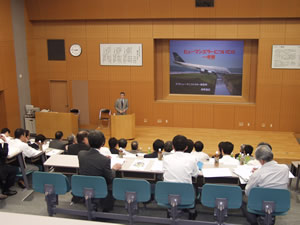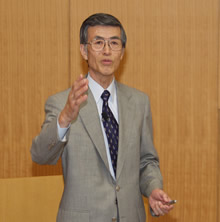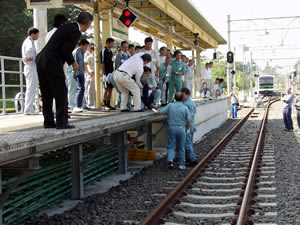|
|
 |

|
On Wednesday, September 20, 2006 and Thursday, September 21, 2006, the 11th Managers Seminar was conducted at the General Training Center of East Japan Railway Company (Shinshirakawa) with the participation of approximately 50 middle managers from member operations, including those from indirect departments, such as design departments.
The seminar consisted of a lecture on lessons learned from recent accidents, problems, unfair practices, and so forth within and outside the nuclear industry, recurrence prevention measures, and human factors that may be considered as their root causes, as well as ethics, organizational factors, and safety culture that forms the basis of them. The seminar was organized not only as a passive lecture for the participants, but also as an experiential and hands-on seminar that would help the participants more actively learn and establish a safety culture.
|
|
Lectures
|
|

Mr. Kuwano
|
1. Wednesday, September 20, 2006
Lecture by Mr. Kuwano, Director of the Human Error Research Office of the Japan Institute of Human Factors
Mr. Kuwano gave a lecture entitled "A Consideration to Human Errors. "
1. What are Human Errors?
It is considered that human errors occur because the characteristics that humans originally have do not fit the environment or condition. Therefore, human errors should be regarded as part of human factors. To understand human errors, we must understand human factors.
2. Reconsidering Human Errors
When studying human errors, it is easier to understand them by classifying them in terms of cognitive psychology. According to James Reason's classification, violations (breaches) are also classified as human errors. Looking at the recent Japanese social phenomena, however, "violations" should be classified as "intentional behaviors."
A deviation is a behavior represented by, for example, "devising a method different from the manual" or "skipping steps because there is not enough time." According to Reason's definition, "driving exceeding the speed limit by 10km/h" is also classified as a deviation.
There is no "intention of causing an accident."
On the other hand, "intentional behaviors" include "deliberation." The recent phenomena occurring in Japan seem to be threatening safety somewhere between "deviation" and "deliberation." They include such behaviors as covering up a known recall, making up data on safety standards, and working out a design that does not meet safety standards. These behaviors have no intention of "murdering people," but may result in killing someone. In fact, people were killed in car accidents as a result of a recall cover-up. Are we supposed to consider these behaviors including recklessness as human errors?
3. Human Factors of "Safety"
There was no intention of violating the law in the beginning, but the standards specified in the law were gradually deviated from and errors are being made that may eventually give rise to a serious accident. I would like to name such human behaviors "lawful paralysis." A lawful nature (or attitude) triggers a deviation - "this much may be acceptable" - resulting in a paralysis.v
In view of these, the recent phenomena frequently occurring in Japan - "Hiding, fabricating, and forging" are problems that seriously threaten safety, but may be considered as problems that should be dealt with in terms of security. v
|

Scene of Hands-on Learning
(Rescue Training Using a Dummy)
|
2. Thursday, September 21, 2006
(1) Hands-on Learning
Hands-on learning and explanation of the facilities: Mr. Masao Sekiguchi, Adviser, Training Department of JR East Japan Personnel Service
Hands-on learning was conducted by using the facilities of the General Training Center of East Japan Railway Company
(2) Learning at the "Accident History Museum" of the General Training Center of East Japan Railway Company
Mr. Masao Sekiguchi, Adviser, Training Department of JR East Japan Personnel Service
We visited the “Accident History Museum” located at the General Training Center of East Japan Railway Company. |
3. Questionnaire
At the questionnaire survey conducted after the seminar, numerous opinions were given as below.
(1) Lecture
・Human errors are attracting a great deal of attention in the field. It used to be said that human errors would be avoided if rules and procedures were established. However, the number of human errors has not dropped. This lecture made me realize that errors cannot be prevented. However, it also gave me an opportunity to think what we should do to reduce them. Although I thought I knew about human errors, I just “thought” that I did. I will try to have a clear picture of human factors in future activities, keeping in mind what the lecturer said. I am thankful for this opportunity because I was able to follow the entire lecture with a fresh feeling.
・The classification of human errors was clearly described, which helped me sort out my own thoughts. Based on the human error classification, I would like to reconsider who has what responsibility for the organization and what kind of measures have to be taken accordingly.
・To work out human factor measures, it was very easy to understand to classify human behavioral errors into human errors and violation errors. All of the recent events posing social issues seem to be arising from compliance violations. I have misgivings about society in which human ethics are being lost. What was said and what was very helpful for us who are in charge of field management, in thinking about what we should do in working out measures against human errors and what we should consider was: “Your natural behavior to protect yourself merely turns out to be an error.” It was very helpful to know that, since human errors are unavoidable, it is important to reduce them and not allow them to expand.
(2) Hands-on Learning
・I was able to learn safety measures that can only be obtained through hands-on experience. I was able to directly learn from JR East’s valuable lessons. I would like to provide some concrete feedback at work.
・I was able to learn a lot in this hands-on learning, such as systems concerning safety measures and activities (education) to improve safe behavior. Although we belong to different industries, our approach to safety was the same and there were a lot of things we should learn.
・I think that I was able to understand through hands-on experience that it is important to start with raising our own consciousness to ensure safety. I felt that the enthusiasm of the lecturer offered a lot of examples to follow. I thought that it was a well-planned hands-on system to let us personally experience how difficult it is to ensure safety. |
|
|
|







